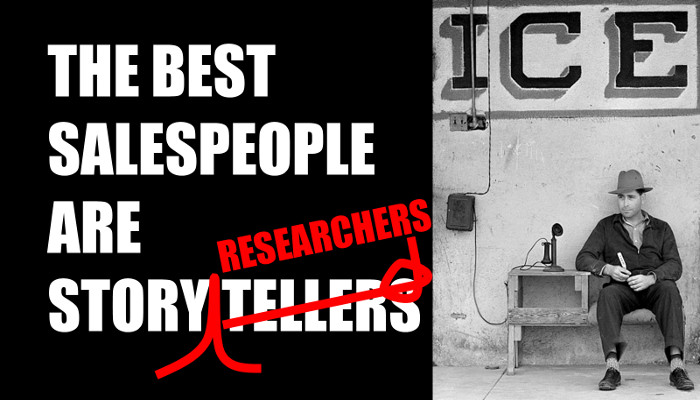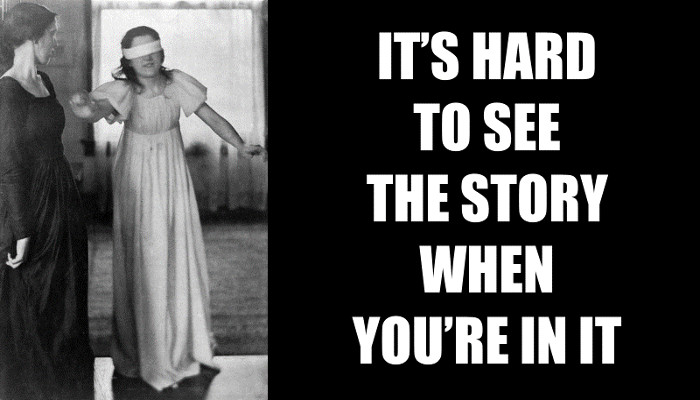by Ron Ploof | Apr 16, 2018 | Business Storytelling

I learned a valuable writing lesson from a movie scene of Ernest Hemingway staring at the blank page. A piece of cardboard with handwritten numbers leans against the wall behind his typewriter. After an awkward moment, Hemingway pencils a zero onto the cardboard. As the camera pulls away, we see that it’s the third consecutive day with a zero. One of the world’s greatest writers reminds us that writing is a marathon instead of a sprint.
But, that’s not what I’ve been seeing recently, as more and more social media posts describe how someone “banged out” ten-thousand words of their next book over the the course of a weekend. Most of these posts are subsequently rewarded with dozens of congratulations for the accomplishment. This may sound curmudgeonly, but what exactly did they accomplish? It’s like congratulating someone for completing a marathon without doing any training. While it’s possible to complete all 26 miles untrained, it’s impossible to do it well.
Banging out ten-thousand words is an accomplishment, it just isn’t the accomplishment. Every good writer knows that those first 10,000 words will contain something like 2,500 nuggets of gold hidden among 7,500 pieces of iron pyrite. And the only way to separate them? Through the hardest part of writing: editing. Magic happens in the editing.
I’ve been working on a manuscript for over a year. Last weekend, I wrote 5,000 words, yet the word count on Sunday evening was actually smaller than the word count on Saturday morning. If I only measured my writing productivity through word count, last weekend would have been considered an #EpicFail.
But, that’s not my goal. My readers don’t care about how many words I’ve “banged out.” They only care about the ones that survived many rounds of ruthless editing.
It’s not the amount of words you write. It’s about the amount of words you keep.
Photo Credit: mpclemens published the image, A lot of ink spilled, through CC BY 2.0.
by Ron Ploof | Apr 9, 2018 | Business Storytelling

I first read SPIN Selling by Neil Rackham thirty years ago. My intent was to learn about high-end selling. What I learned instead was the power of story research.
Most sales training is built upon three skills:
- probing
- objection handling
- closing
But Rackham’s research found that the most successful sales representatives didn’t excel in these areas. His team found that while these skills proved effective for low-value, transactional sales, they fell short as price-tags rose and lead-times extended. For these expensive sales, he recommended using his SPIN strategy–an acronym that represents Situation, Problem, Implication, and Need-Payoff.
While I don’t remember the book making this connection directly, the SPIN strategy is the foundation of any business story. For example:
Once upon a time, everything was going well.
Then a situation happened.
The customer researched the situation and found a big problem.
If this big problem wasn’t solved, the customer would suffer implications.
Although the customer found many solutions to the problem, she wondered, “Was it worth the cost?” What was the need-payoff? Would the solution solve the problem, stave the implications, and ultimately, provide a payoff?
The best salespeople aren’t necessarily great storytellers. They’re great researchers. They ask questions to uncover a prospect’s situation, the problem to solve, the implications of not solving the problem, and need-payoff. If they’ve done a good job at uncovering these things, they’ll have gathered the ingredients for the ultimate sales pitch: the customer’s story.
Photo Credit: Lee, Russell, photographer. Ice for sale. Harlingen, Texas. Cameron County Harlingen Texas United States, 1939. Feb. Photograph. Retrieved from the Library of Congress, https://www.loc.gov/item/2017782201/
by Ron Ploof | Mar 26, 2018 | Business Storytelling

Hindsight is 20/20 for one reason: we know how the story ends.
While it’s easy to criticize our predecessors, we need to cut them some slack because they didn’t know what we know–how their story ended. While we sit on the high perch of knowledge, they struggled with incomplete information and ignorance of the true motivations of all the historical players.
It’s nothing new. Mocking previous generations is a rite of passage for subsequent ones who can scoff at the absurdities of believing that:
- the sun revolves around the earth
- bloodletting cures all ills
- one human can own another human
- only male landowners can vote
- Twinkies are bad for you (What? You haven’t heard?)
But we evolved. And that’s the point. Our beliefs are ever changing. Don’t believe me? Try the following exercise.
I used to believe X, then Y happened.
For example:
- I used to believe in nurture over nature, then I had kids
- I used to believe that there was no such thing as age discrimination, then I hit middle-age
- I used to believe in over-planning, then life taught me flexibility
It’s hard to see the story when you’re in the middle of it, which is ironic considering that future generations will mock our “enlightened” ideas during their own rites of passages. Therefore, before we get too confident in our present-day beliefs, remember that we too are in the middle of our own incomplete stories and the only thing standing between us and their endings is time.
Photo Credit: White, Clarence H, photographer. Blind man’s bluff, Newark, Ohio,/ Clarence H. White. Newark Ohio, 1898. Photograph. Retrieved from the Library of Congress, https://www.loc.gov/item/97509542/
by Ron Ploof | Mar 19, 2018 | Business Storytelling

A child plays alone in the corner. She raises a wooden block, lets it go and squeals in delight as the cube falls to the floor. Similar tests lead to similar results and so she tries something different. She raises the block higher and observes that it hits the floor harder. With each experiment, she learns something new.
Children learn by telling themselves stories that explain the results of their tests. The trajectories of those stories depend upon three possible test results: positive, negative, or neutral.
| Test |
Example |
Positive results confirm existing knowledge
|
The higher I raise the rubber ball, the higher it bounces |
| Negative results lead to new knowledge |
Changing the color of the rubber ball does not change the height of its bounce |
| Neutral results teach us nothing |
Although I can hear the ball bounce in the dark, I can only assume how high it bounced since I can’t actually observe it |
We’re always testing. We taste-test while cooking food, test our brakes before heading down a steep grade, and test the temperature of our bath water before splashdown. Customers test too. They’ll read online reviews to test owner reactions and test their purchase decisions with upper management, peers, and direct reports. And finally, storytellers are master testers. Storytellers test their characters wills, the soundness of their ideas, and the way each responds to the repercussions of their actions.
It’s all about the test. So, what tests are you using in your stories?
Photo Credit: Leffler, Warren K, photographer. Drunkmeter Test. , 1965. Photograph. Retrieved from the Library of Congress, https://www.loc.gov/item/2016646642/.
by Ron Ploof | Mar 12, 2018 | Business Storytelling

It’s called a green leaf, Ancestry.com’s notification symbol for a new genealogical hint to follow. Most ancestry stories start by clicking on a leaf. Mine, however, ended with one. On February 10, 2018, the clues hidden behind this iconic symbol led me to solve a forty-two-year-old mystery.
The story starts with a thirteen-year-old me exploring the dusty attic of an old New England home. Daylight streamed through a double-window, illuminating an open-top cardboard box filled with various personal items. I sorted through its contents until something caught my attention–a stack of old postcards filled with turn-of-the-century images of New England, New York, and Washington D.C.
Those post cards have followed me ever since. Periodically, I’d pull them out of a desk drawer and comb their ancient images for any story clues. Little did I know that the real story awaited on the flip sides of those cards. One day in 2012, as I’d done hundreds of times before, I pulled the cards out of the drawer. But this time was different. Instead of performing my usual photographic inspection, I decided to study their fountain-pen inscribed messages.
A pattern emerged quickly. Eighty-six of the postcards were addressed to a Mrs. Lizzie Milligan and my inner storyteller wanted to know more. Who was she? What was she like? Who were Nellie, Sadie, Frank, Ella, Tom, Joe, Ruthie, Margaret, Debby, Mamie, and Kathryn? Why did so many of the messages end with “give my love to the girls?” Who were they? Her daughters? Her sisters? Something more…hmm…interesting?
And so I went to work. Google and Ancestry.com helped me uncover three major life milestones:
- Elizabeth Nestor was born in Montreal, Quebec, Canada in January 1868
- She married Patrick Milligan on June 22, 1885
- Elizabeth and Patrick’s son, Edward, was born on March 24, 1886
Three simple facts that described a typical family story. Until I uncovered a less typical one.
- Patrick Milligan died of tuberculosis in Boston, Massachusetts on November 10, 1890
All stories are built upon facts and told through context. Therefore, seventeen-year-old Elizabeth Nestor married 22-year-old Patrick Milligan in Montreal, Canada. Patrick died of tuberculosis nine years later, leaving Elizabeth as a 26-year-old single mom in a strange land with an eight-year-old son.
This new context changed my motivations from simple curiosity to one of empathy. I had to know more, so I expanded my search beyond digital media. I snail-mailed city clerks, read old books hidden in rarely-visited sections of libraries, found newspaper articles on microfiche, and read names and dates etched deeply into granite headstones.
On January 13, 2014, I launched projectlizzie.com to share my research and tell two parallel stories: Lizzie’s life story and my crazy quest to find it. Over the next fourteen months, I published thirty-eight articles. Then, all progress came to a screeching halt.
Up until this point, I’d interacted with people who were paid to be helpful: city clerk’s, librarians, cemetery caretakers. But, the facts that they helped me uncover were limited. It’s like I could only paint Lizzie’s portrait with a sepia palette. I realized that the only way for me to to add color to these drab facts would be to speak with someone who actually knew Mrs. Lizzie Milligan.
That’s when Project Lizzie got a little weird.
Working with fellow researchers is one thing, but reaching out to Lizzie’s relatives involved crossing some societal line. Relatives would have a more emotional connection to Lizzie’s story and therefore might feel a need to protect her memory. So, I reached out in the only way I knew how–with respect, humility, and total transparency.
It didn’t go well.
Fortune had it that one of Lizzie’s great-great nieces and I were about the same age, grew up in the same hometown, and she still lived there. I never could have predicted what she’d do with that information. She called my seventy-something year old mother!
“Some woman just called me asking if you were a scammer,” Mom said breathlessly. “She was really upset. She said something about postcards and had lots of questions. She asked if my son’s name was Ron. I said, ‘Yes.’ She asked if you lived in California, and I said, ‘Yes.’ She asked how long I lived in town. I said, ‘Fifty years.’”
This wasn’t why I started Project Lizzie. I never intended to upset anyone…especially my mom. And so, after a few more failed attempts to contact relatives, I decided to leave Lizzie’s story to fate. I hoped that some future, less-skeptical relative would somehow find the Project Lizzie website and reach out to me as opposed to the other way around.
I waited almost three years.
That’s when Ancestry.com’s little green leaf led me to a major break in the case. Someone named Ken had uploaded a portrait of the Cardinal family–the family that Lizzie lived with for her entire life!
I contacted Ken immediately. Rather than acting suspiciously, he went out of his way to help. Rapid-fire emails resulted in Ken introducing me to his Uncle Fred–who actually lived with Lizzie as a boy! Uncle Fred added color to my palette by telling me little stories about her and ultimately answered my two outstanding questions
- What did Lizzie look like?
- How did the cards get into the attic?
Uncle Fred explained that when Lizzie’s sister Ellen died, the family sold her house in Malden, forcing an 82-year-old Lizzie to find another place to live. She moved in with her niece at 2 Edgemont Ave in Billerica–the same house that I found the cards in! Ken’s sixty-eight-year-old memory had just traced the postcards directly from Lizzie’s hands into mine.
That left my final question. Did Uncle Fred have a photograph of Lizzie?
He did.

This is the only known photo of Elizabeth (Lizzie) Nestor Milligan. She’s the 72-year old woman on the far right of this circa 1941 photograph.
It took time to get there; most worthwhile stories do, but Project Lizzie had finally arrived at a satisfying ending.
If you’re interested in learning more about my quest, checkout the Project Lizzie website. While there, flip through the Postcards database. And if you’re really adventurous, follow my journey through the Chronology page.
by Ron Ploof | Mar 5, 2018 | Business Storytelling

One of the best things about being a storyteller is the god-like control we hold over our characters. But, with all great power comes great responsibility. If a story is the result of people pursuing what they want (StoryHow Mantra), storytellers must choose how to satisfy those wants.
I bought my first car when I was sixteen. My 1969 Cutlass Supreme was big, fast, and fun to drive. Its powerful 350 engine could pass anything…well, except for a gas station. It drank gasoline like a thirsty camel which ate into my meager earnings as a student and part-time employee. And so, I sold the gas-guzzler to get a more fuel-efficient one: a 1974 Fiat 128.
And I got EXACTLY what I wanted. My gasoline expenses plummeted–yet not for the reasons that I expected. When the car actually ran, it used a thimbleful of fuel. However, the money I saved in gas bills was swamped by the vehicle’s repair bills.
Storytellers have two choices when granting their character’s wishes: give them what they ask for or what they expect, but never both. One or the other leads to a story. Both leads to a boring marketing pitch.
Option One: Give characters exactly what they asked for, but not in the way they expected.
- King Midas wanted everything that he touched to turn to gold, before thinking through the whole eating thing.
- Ron wanted a fuel efficient car and got one that didn’t run.
Option Two: Give characters what they expected, just not in the way they had envisioned it.
- Sharon asked for a fish, but got a fishing rod.
- Sam prayed for money and was offered a back-breaking job.
A story is the result of people pursuing what they want. So, always remember the immortal words of Mick Jagger and Keith Richards:
You can’t always get what you want, but if you try sometimes, you just might find, you get what you need.
Photo Credit: image by Irog through Creative Commons: Attribution-ShareAlike 2.0 Generic.






